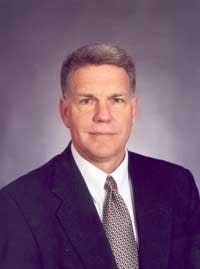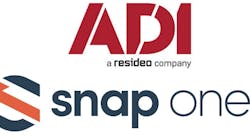Con-Way Transportation Services' Director of Corporate Protection Curtis Shewchuk was recently named by the American Trucking Association as their Security Director of the Year. After a long and honored background in law enforcement that saw him learn the ins-and-outs of transportation and the fight against narcotics, Curt ended up at Con-Way, a $2.6 billion regional trucking subsidiary of CNF.
Prior to joining Con-Way, he served 14 years with parent company, CNF, as Region Manager, and then as Senior Program Manager where he developed international supply chain security programs for Menlo Worldwide and Emery. Following his time at CNF, Shewchuk was appointed director of security for Con-Way Transportation Services in March 2003. His job detail makes him responsible for managing Con-Way, Menlo and CNF’s global security and homeland security programs.
Under his charge are more than 450 brick and mortar facilities, close to 18,000 employees, 8,000 tractors, 20,000 trailers, and operations that span across 20 countries. Even though his hands are full working with the government to make sure Con-Way's security meets the ever changing standards, he was able to open up an hour to sit down with SecurityInfoWatch.com editor Geoff Kohl to discuss the challenges being seen today.
The other half of this interview (a portion which focuses more on homeland security concerns inside the trucking sector) appears on the "Back Page" of the November 2005 issue of Security Technology & Design, and will be available in early November.
HOW MUCH ARE THE CUSTOMERS SETTING SECURITY STANDARDS IN YOUR BUSINESS?
Shewchuck: In the 3PL (third party logistics) environment, security trends have gone towards the RFQ/RFP. Some customers get very specific in terms of security compliance to their supply chain needs. Especially with high-value products like the high-fashion and high-end retail electronics product line, they are often setting the standards of what they expect for their cargo.
WHAT ARE YOU SEEING IN TERMS OF EXTERNAL THEFT TRENDS?
Shewchuck: In terms of external theft we face issues like that of cargo theft. Over the years, the industry has experienced trends in higher levels of cargo theft. There are high-tech shipments that have been at risk in certain areas. One of the problems is that there's no real cross-industry collection of data on cargo theft. The way to overcome this would be to have cargo theft be a part of the government's Uniform Crime Reporting system. There is a lot of speculation in terms of cargo loss globally, and right now we can only base our response on our anecdotal data. No one can really say how bad it is in terms of the global situation. Our companies' [loss] numbers are very low, but again this is partly because we recognize the value of our employees as security stakeholders.
YOUR COMPANY IS DOING A GREAT DEAL OF INTERNATIONAL SHIPPING. HOW DO YOU STAY UP-TO-DATE ON THE INTELLIGENCE WHICH YOUR EMPLOYEES NEED?
Shewchuck: Really, it's about the partnering. It means working very closely with industry groups and with the private sector security community. One of the greatest tools is the Department of State's OSAC (Overseas Security Advisory Council) program. OSAC is able to send us electronic e-alerts about what's going on in each part of the world. It keeps us up-to-date on health alerts like tracking the bird flu, to terrorism concerns and political unrest.
YOU'VE HAD YEARS WORKING TO SECURE CARGO TRANSPORTATION. WHAT IS THE MOST NOTABLE CHANGE YOU'VE SEEN OVER THOSE YEARS?
Shewchuck: I think one of the most notable things is when we started communicating between transportation companies through the regional security councils. Before that point, some five or 10 years ago, we weren't sharing information and trends and intelligence. This has been one of the keynote effects of the ATA. Ten years ago we were talking about that, about how we needed to start that sharing process. It was something that we at Con-Way were always advocating -- that people need to communicate about security. The other real change in the experience is having that working relationship between the government and the private industry. I think that the transportation industry bring a tremendous amount of expertise. The private sector can advise the government, and we can work together to come up with smart, cost-beneficial programs.
WHAT WERE KATRINA'S EFFECTS ON THE CON-WAY SECURITY RESPONSE AND WHAT WAS LEARNED?
Shewchuck: All of us are addressing the concerns that we've had post-Katrina. Katrina was really the first test of everyone's disaster recovery and emergency planning in the post 9/11 environment. As far as our response, there's a real sense of commitment that our people and our services are keeping the country's supply chain open, whether it's through the fires in California or hurricanes and flooding in the Southeast. As far as Katrina goes, I think we had been through situations like that in the past. We had plans on how to conduct the response, knowing that we would lose communications during the process.
CAN YOU EXPLAIN YOUR APPROACH TO THE USE OF PRODUCTS AND TECHNOLOGY TO YOUR SECURITY PLAN?
Shewchuck: We always look at both the high-tech and the low-tech solutions to security challenges. So we're always analyzing the new technologies. When we look at technologies, we look at the security and operational benefits together, and depending on the mode of transportation you're looking at different technology needs for security. In our environment, we mix low-tech and high-tech response. We focus on training our people so that each one of them is trained on the security issues and is part of the security response. It's using all of our employees as security stakeholders. They all bring resources in terms of securing the supply chain, and this is part of the low-tech response to our process.


